Techniques for keeping and breeding clown treefrogs (Dendropsophus leucophyllatus, formerly Hyla leucophyllata).
From my earliest fieldwork in South America, I’ve been captivated by the beauty of the clown treefrog (Dendropsophus leucophyllatus, formerly Hyla leucophyllata). These frogs are common around human settlements, so the species and humans seem to mingle well. They are likely equal in encounter rate to something like the hatchet-faced frogs of the genus Sphaenorhynchus. Anyone who has worked anywhere in these species’ range for any length of time just can’t miss them. For example, both the clown treefrog and Sphaenorhynchus can be readily observed in cesspools covered with floating vegetation in and around the Amazonian city of Iquitos.
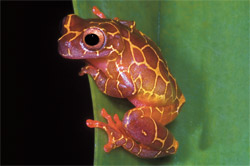
Photo Credit: Danté Fenolio
A smaller member of the family Hylidea, clown treefrogs have a striking pattern. The giraffe phase is undoubtedly one of the most brilliant patterns of any hylid frog in South America.
Because clown treefrogs aren’t hard to find across the Amazon and the Guyanas, they have become a semiregular import in the pet trade. Proof of their long-standing status as a commercially important species can be found in the many images of captive specimens appearing on items such as calendars, stationary, books and pet trade literature.
Wild Clown Treefrogs
The clown treefrog is the namesake species for a group of related frogs that also include Dendropsophus anceps, D. bifurcus, D. ebraccatus, D. elegans, D. rossalleni, D. sarayacuensis and D. triangulum (Faivovich et al., 2005). If the genus Dendropsophus sounds unfamiliar, all are former members of the genus Hyla (Faivovich et al., 2005). Frogs within this group are smaller members of the family Hylidae and the subfamily Hylinae. Most never exceed a couple of inches in total snout-to-vent length. Most of these species have a darker brown base color with yellow, tan or cream markings.
Dendropsophus leucophyllatus exists in a variety of patterns, some of which are considerably different in appearance. In fact, the giraffe phase morph of D. leucophyllatus was described and recognized at one time as a separate species, Hyla favosa, which was later synonymized with the then H. leucophyllata by Titus, Hillis and Duellman (1989).
In the wild, the clown treefrog group generally breeds around temporary forest pools or “floating meadows.” A floating meadow is an oxbow or slow-water area of a river where the surface is covered by floating plants such as Pistia and/or Eichhornia spp., among other aquatic floating and emergent plants. Most of the frogs in this group can also be found around forest clearings with ponds.
Clown treefrogs have a distinctive raspy call with a harsh primary note followed immediately by several equally raspy but shorter notes. Often eggs are deposited on leaves immediately above water. Hatching tadpoles drop into the water and live along the bottom of the aquatic system. At the right times, large breeding aggregations of clown treefrogs can be observed with hundreds of frogs participating in the event.
The Right Setup for Clown Treefrogs
If these frogs are maintained properly, they are truly hearty in captivity. They live at least four to five years in captivity, and they will fill the area around them with their loud vocalizations at night.
Clown treefrogs do well in a taller vivarium. Try to provide — at minimum — 30 inches of height from the substrate. These frogs thrive in a vivarium with controlled ventilation so as to allow the slow turnover of air with the maintenance of an internal microclimate having a higher humidity. For example, Exo Terra terrariums have a screen built into the enclosure’s top and ventilation ports on the face of the units below the front opening doors.
These elements provide quite a bit of ventilation, perhaps too much for clown treefrogs if the terrarium is kept in an air-conditioned home. This can be easily remedied by placing a custom-cut piece of glass over the top of the terrarium. I place small squares of cardboard at each corner of the top, under the glass, so the glass is lifted up off the top slightly. This modification slows air movement but doesn’t eliminate it. I have a group of clown treefrogs maintained in exactly these circumstances.
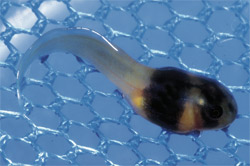
Photo Credit: Danté Fenolio
Clown treefrogs breed on aquatic vegetation. Their eggs are deposited on leaves immediately above the water. Tadpoles have an interesting black marking that makes them easier to identify.
Clown treefrogs flourish when provided with live plants. The leaves should be large and strong enough to hold the frogs’ weight. Including live plants requires a lighting system that can accommodate them. A full-spectrum fluorescent bulb, which is replaced every four to six months, is ideal. A 12-hour light-dark schedule works fine, and a timer automates the system nicely. With healthy live plants, the frogs have plenty of places to climb and sleep. A cork bark piece or two and some well-placed thin branches top off the items that help provide cover and climbing material.
I am picky about what I use for substrate and how I arrange it. I like to use terra cotta balls, such as Hydroton, as a base layer of substrate in terrariums. The spaces between the balls can accommodate excess water and keep it away from terrarium occupants. Stagnant water in a terrarium can cause bacterial problems with amphibians. Conversely, you want your substrate to maintain its moisture. Damp terra cotta balls and the water between them become your terrarium’s moisture reservoir. The balls can absorb water and release that moisture as the upper substrate dries.
For the upper substrate, I have used two different mediums. I like crushed coconut shell, which is widely available commercially in pet stores. It is sold in dry bricks that can be moistened. I also use true sphagnum moss. If you opt for the ground coconut shell, a shallow layer of moss between the ground coconut shell and the terra cotta balls prevents the shell from filling all of the spaces between the terra cotta. Either of these substrates works well.
Clown Treefrog Care
Temperatures are not as critical with clown treefrogs as they are with other tropical amphibians. I have maintained this species at a wide range of temperatures, but I focus on preventing the nighttime temperatures from dropping below the low 70s or high 60s (Fahrenheit). Daytime temperatures should not exceed the mid-80s. Maintain humidity by misting the enclosure once a day. Make sure some moisture is in between your terra cotta balls at the base of the substrate mix. Add water accordingly.
Regular access to clean, fresh water is a must for nearly any captive amphibian. Use a plastic or ceramic dish that you can easily access. Make sure to change the water, and maintain a shallow amount of clean water at all times. Often, crickets jump into the water dish and drown, and dead crickets quickly foul the water. This problem can be avoided by placing the water dish on top of an upside down terra cotta flowerpot, which raises the level of the water dish. The odd cricket that escapes your feeding dish (described below) is far less likely to end up in the raised water dish. The elevated pool of water will not change accessibility for your frogs.
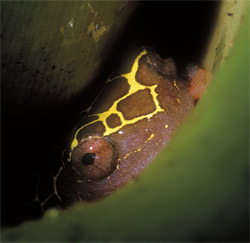
Photo Credit: Danté Fenolio
The giraffe phase of Dendropsophus leucophyllatus is typically associated with the upper Amazon Basin.
Feeding can be accomplished easily in a smooth-sided glass dish. A glass dish with taller sides is ideal. Crickets can jump several inches in height, and you want to contain them in the feeding dish.
The advantages to using a feeding dish are several. First, the food is always in the same place, and the frogs become accustomed to a feeding station. Second, because the frogs are conditioned to feeding from the same dish, they are more likely to try any appropriately sized live food item you place in the dish. I have been able to use this trick to get various frog species to try live food items I otherwise was not able to get them to eat. Third, by confining crickets to a feeding dish, they cannot crawl down into odd corners of the terrarium or into the medium and die. Finally, a quick glance into the dish is all that is needed to know how much food is available for the frogs. Making sure live food is regularly available is a big part of the long-term maintenance of healthy amphibians.
Occasionally wash the feeding dish. The walls of the dish accumulate debris from the frogs crawling in and out of it. This debris ultimately provides the crickets with a gripping surface, and they will begin to escape from the dish.
Gut loading food items is another important part of maintaining healthy captive amphibians. The term refers to feeding a food item, such as crickets, a rich diet before offering it to an amphibian. This procedure helps supply nutrients to captive animals. Gut-loading ingredients are often diverse. There is no single ideal formula, and perhaps if science had a better handle on what amphibians require nutritionally, we would realize that different species require different levels of various vitamins and minerals.
In my more than 25 years of working with amphibians, I have always done well with squash. I like yellow squash, spaghetti squash, pumpkin, acorn squash, etc. Squash is good for you as well, so why not buy some at the market and provide your crickets with the internal parts you won’t eat? Other appropriate gut-loading material includes kale, chard, spinach, bok choy, small amounts of carrot mixed with other ingredients, and other leafy greens.
All should be thoroughly washed with a liquid dish soap to ensure any pesticide residues are removed first. Gut load crickets 24 hours before feeding them to your amphibians. I also dust crickets every other feeding with Heptivite vitamin and mineral supplement. I have also used Rep-Cal calcium supplements every third feeding.
Using a Rain Chamber
Clown treefrogs have been captively reproduced on a sporadic basis for years. Breeding this species usually requires a rain chamber (RC), which I will detail briefly. The RC creates conditions in an enclosure that simulate a rain storm. The RC also provides appropriate egg deposition sites.
Several factors need to be considered in setting up a RC. First, “rain” can be generated through two possible avenues. You can use a misting system that draws from a reservoir of clean water. It includes an overflow in your RC for excess water to drain and leave the system. The second avenue includes a recirculating system. A pump draws water from a pool in the bottom of the enclosure and pushes that water through plumbing and back out of a spray bar or sprinkler head at the top of the enclosure.
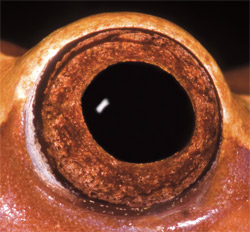
Photo Credit: Danté Fenolio
Clown treefrogs have bulging eyes that add to their charming personality.
Using a misting system and a reservoir of fresh water has the advantage of always showering clean water onto your amphibians and hopefully onto their eggs. When I say “clean” water, I mean water without high bacterial loads. This system best simulates natural conditions, but the downside is that the reservoir needs refilling. If you need to mist the frogs for a longer period of time, it can be a difficult job to keep up with.
I have seen this problem circumvented by plumbing the misting system directly into a water supply. Then water is drawn through a carbon filter to remove chloramines/chlorine. The design is a bit more involved, but it eliminates the key drawback of the misting system approach. A timer can be used to automate this system, but know that if you don’t refill the reservoir and the timer comes on, the pump can burn out and may become a fire hazard.
The second design, a recirculating system, does not require the constant water supply, and it can be run for extended periods. However, as the frogs defecate in the water, bacterial counts in the recirculating water climb. This may not be a problem for adult frogs, but freshly deposited eggs are vulnerable. Never mist on freshly deposited eggs using a recirculating system. The likelihood of a bacterial problem with the egg clutch is high. In addition, these systems require frequent water changes.
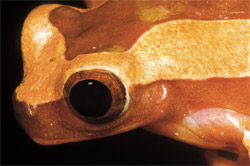
Photo Credit: Danté Fenolio
The standard phase of the clown treefrog is set on a background color of brown. The pattern ranges from a light cream color to a brilliant yellow.
The design can be augmented to easily address this problem. For example, I described in a previous article (Fenolio, 1996) a RC with an external pump that distributed water to several possible outlets through a series of valves. These valves distributed water three ways: recirculating it into the base pool of the RC, pushing it through misting heads plumbed into the top of the enclosure, or through an alternate valve where the water could be diverted to a drain. This third option made water changes of even larger volumes a short task. An in-line filter was also included so biological filtration was maintained in the same manner as someone uses a biological filter in an aquarium. The pump used to create the rain can be automated through the use of a timer.
There are other RC system considerations aside from the two described above. Water temperature can be used to change temperatures in the RC if a temperature swing is one factor that cues your frogs into breeding. I have not used temperature swings to breed clown treefrogs, but they may respond to them. A simple submersible aquarium heater works in both systems.
Further, live plants can be maintained in a rain chamber through several measures. I recommend using plant species, such as Philodendron or other viny, aerial-root species, that can be raised and maintained hydroponically. This way, no dirt is introduced into the system as a potential source of bacterial contamination. Appropriate lighting needs to accompany live plants.
Rainy Reproduction
Providing proper egg deposition sites is a must in any RC design. Clown treefrogs deposit eggs on the leaves of floating aquatic plants. For my frogs, I adjusted the water height in my RC, raising it to 6 or 8 inches. I added water lettuce (Pistia sp.). These plants float on the surface and have leaves that can hold the weight of the frogs and their eggs. Water hyacinth also works. Note that the long root systems of these floating plants can clog up an internal pump, and a modification of your RC design is necessary to keep roots from tangling up the impeller of the pump. This can easily be accomplished with an intake screen.
Another consideration for a RC includes determining when you rain on your frogs and the duration of these showers. I like to start the rain an hour or so before the automated lighting systems turn off. At first, I rained on the frogs for several hours into the night. I usually shortened the showers to one or two hours, split between just before the lights turn off and after they turn off.
I also rained on my frogs when storm systems passed through. This way, I had the advantage of decreased barometric pressure, which appears to be a cue for many frogs to initiate breeding.
Often frogs don’t breed right away. Every species responds to RC conditions differently. The group of clown treefrogs I bred did so after about 10 days of the described conditions. I have had to maintain groups of the yellow-eyed leaf frog (Agalychnis annae) in my RC for periods exceeding a month before they bred.
Increased humidity can heighten the likelihood of bacterial infections, and long periods of time in the RC especially multiplies these problems. If the frogs’ skin becomes red or if open sores develop, return frogs to their regular enclosures with a decreased humidity and seek immediate veterinary assistance. Successful amphibian breeders keep a close watch for signs of trouble in the RC. Always make sure easy pathways are available for amphibians in an RC to exit the water and take refuge in a protected site. Provide some ventilation to help reduce the likelihood of bacterial problems, and don’t forget to make regular water changes.
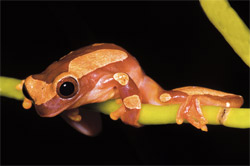
Photo Credit: Danté Fenolio
Clown treefrogs vocalize when barometric pressure changes accompany an approaching storm.
Tadpoles and Juvies
After a number of days in the RC, clown treefrogs deposit their eggs on the leaves of live plants at or above the waterline. Average clutches in captivity typically range from 400 to 600 small eggs. Leave the eggs in the RC undisturbed, and they will hatch, depending on temperature, from five to 10 days later. Tadpoles spend most of their time on the bottom of the enclosure.
The young accept a wide variety of fish foods, including sinking pellets and small pieces of frozen fish foods. Experimentation with various foods is necessary, but I recommend starting with Sera Micron. It will sink after a while, and the tadpoles will feed on it on the bottom. Also dependent on the water temperature, amount of available food, and density and period between water changes, tadpoles metamorphose anywhere from two to five months. I recommend regular water changes of 25 percent or less as well as biological filtration, either through a sponge filter or other means. Limit strong water circulation because these tadpoles are not adapted to strongly moving waters.
Metamorphic frogs require an enclosure offering humid corners as well as regular ventilation. Too much humidity will lead to skin infections. Metamorphic frogs require a lot of available food and access to clean water. Make water available but keep it shallow; small frogs can easily drown. They like a terrarium well-planted with live plants.
Clown treefrogs are an excellent species to work with in captivity. They are hearty, can live for years and will breed in captive circumstances. These attractive frogs fill homes with their quirky vocalizations at night, and they are especially vocal when the barometric pressure decreases with an approaching storm. Best of luck with your clowns!


